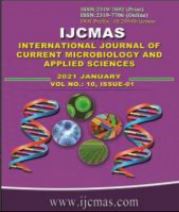


 National Academy of Agricultural Sciences (NAAS)
National Academy of Agricultural Sciences (NAAS)

|
PRINT ISSN : 2319-7692
Online ISSN : 2319-7706 Issues : 12 per year Publisher : Excellent Publishers Email : editorijcmas@gmail.com / submit@ijcmas.com Editor-in-chief: Dr.M.Prakash Index Copernicus ICV 2018: 95.39 NAAS RATING 2020: 5.38 |
Agriculture continues to be prominent sector for the Indian economy as it is the primary source of livelihood for over 58 % of the nation’s population and generates employment opportunity for 44 % of the workforce. Farmers depend on climate to reap good harvest. The loss in one or more seasons will arrest the routine activities of farmers as their main source of income is from agriculture, this crisis will make life complications and farmer takes drastic step of committing suicide. In this background, a study was conducted in Mandya district of Karnataka to understand the factors responsible for suicides among the farmers. The list of the farmer suicides and the families of the same who availed the compensation of Rs. 5 lakh was considered for obtaining the information on the affected farmers from the Karnataka State Department of Agriculture. Personal interview method was followed in collecting the data. The data was analysed using percentage and frequency. The results of the study revealed that, less than half (46.66 %) were of old age group, 43.33 per cent were illiterates. Majority (70.00 %) of them were practicing agriculture as the main occupation, 63.33 per cent of them had high level of farming experience. More than half (53.33 %) of them were large farmers, majority (70.00 %) of them had nuclear family type. Further, 70.00 per cent of them belonged to Other Backward Class (OBC), 46.67 per cent belonged to medium level of cosmopoliteness, half (50.00 %) had medium level of mass media exposure, more than half (56.67 %) had low level of extension agency contact and extension participation. 46.66 per cent had medium level of economic motivation, half (50.00 %) had medium level of scientific orientation, 46.66 per cent of them had medium level of information seeking behaviour, more than half (56.67 %) had medium level of innovativeness, 43.33 per cent of affected famers had medium level of risk orientation, 60.00 per cent had medium level of management orientation, more than half (56.67 %) had medium level of decision making ability and less than half (46.67 %) had high level of deferred gratification.
 |
 |
 |
 |
 |